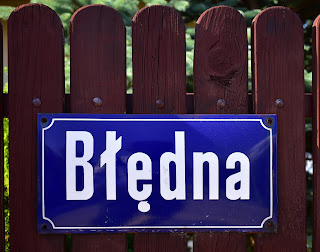"I remember when this was all fields". Well I do! They are going quickly, devoured by developers and road-builders. Soon, the countryside ringing Warsaw will be built up as densely as its suburbs as rural Poland continues to be pushed back from the city's borders.
Below: a rural scene squashed between the new estates of Zamienie to the left and the S7 extension to the right, both out of shot.
The S7 is cutting through the landscape, separating villages and communities, displacing wildlife and changing forever the klimat of the place. Below: ulica Dawidowska will soon disappear. It has been moved sideways over a temporary bypass of concrete slabs while the old road is ripped up to make way for the surface of the S7 which will traverse the old alignment. Pedestrians and cyclists can cross over from Zgorzała to Zamienie using the new footbridge currently under construction, but motorists will have to take a l.7km detour over the new viaduct crossing the S7 and Dawidy Bankowe. This is expected by September.
Below: Zamienie has been cut off from Zgorzała; this is the view of Zamienie from ul. Postępu, Zgorzała's main drag. Soon, acoustic screens will wall off one community from the other; the howl of traffic will in any case still be heard.
Looking the other way, from Zamienie towards Zgorzała, below. A tipper truck heads south along what will be the eastern service road running parallel to the S7, which at the moment is but a sand-coloured hard-top waiting for the final layers of asphalt. In the distance, the backs of houses on ul. Postępu.
Another view of the backs of houses - or rather farm houses - on ul. Postępu. Still very much an agricultural community, many local farmers have not only lost significant amounts of land to the S7, but they have also lost access to their outlying fields.
Below: mounds of soil stockpiled for the construction are disappearing, rows of crops in the foreground. One word sprang to my mind as I viewed this scene - countrycide.
A few hundred metres west, and this is Zamienie. Spare a thought for the inhabitants of Osiedle wśród pól ('Estate Amid The Fields', below); one day they woke up and found they were no longer living amid the fields; a block of flats has popped up behind them, while across ul. Raszyńska, Nowa Wola's modernist estate is creeping ever closer; Zamienie's old vaccine plant is filling up with houses and flats, and an expressway will run within 400m of these gates.
One thing, however, is constant for these folk is that access is as hard as ever and getting worse. Ul. Raszyńska remains asphalt-free; the road is dusty when the sun's out and muddy when it rains. Still, at least they can justify owning a 4x4 out here. But then the cost of owning one means they can't afford to live in town.
Left: looking north-west along ul. Raszyńska towards Nowy Podolszyn. Once the road gets to the border, it becomes ul. Złota and acquires asphalt. And the south-east end of ul Raszyńska has been closed off because of the S7 works. One day, that end of Raszyńska will be rerouted over the expressway via a new viaduct; until then, the only way in and out of Osiedle wśród pól is either via Nowy Podolszyn or Dawidy Bankowe (currently suffering from temporary traffic lights and single-lane working on ul Starzyńskiego). Right now, it must be hell to get in and out by car - and this place is not well located for public transport, with the nearest bus stop 1.3km away, and W-wa Jeziorki station 2.3km away.
Below: far away, across the fields (7km in fact), the Raszyn radio tower in Łazy (pron. 'Wuzzy'). The power lines running from left to right are the ones seen in the photo above. The 'dehaze' slider on Photoshop pulled all the way across to the right to extract the maximum detail from the mast.

Below: the fields are being pushed back; through the trees to the left, you can just make out new blocks of flats being built at the western end of Zamienie; to the right of these fields, the village of Łady (pron. 'Wuddy') is also expanding. Won't be too long before these fields disappear altogether.
Is this all a mistake? An error on the part of planners? Is this any way to run a country?
Left: ulica Błędna, Zamienie.
Błędna literally means incorrect, erroneous, fallacious, wrong, unsound, false or mistaken.
The city is creeping outward, unplanned sprawl, the worst form of urbanisation. At least Jeziorki, under the flight path to Warsaw Okęcie airport, is spared such ravages, and being in Warsaw, Jeziorki has adequate public transport. Having said that, new houses are being built at an ever-faster rate - though no big estates nor anything over 12m high. Typically either single houses or small developments of four or five houses.
Ah yes - good news for Jeziorki - the planned estate for 8,000 people next to the tracks on ul. Karczunkowska won't happen.























































